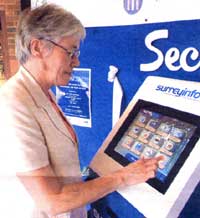News
Government Gets in the Kiosk Game in UK
In response to a British government directive, local communities are experimenting with kiosks as a way to deliver services.
December 3, 2002
Lilian Wisdom is MD of Marketplace Interactive, a UK company which specialises in interactive kiosk solutions, providing hardware, software and consultancy.
 |
Lilian Wisdom |
Local government in Great Britain is facing an enormous challenge. By 2005, all local authorities need to be able to deliver 100 percent of services electronically. The driving reasons behind this e-government initiative are to deliver services more effectively and efficiently, and to give the citizen more choice as to when, where and how they interact with government.
Recognising limitations
There is a proliferation of initiatives to put services on-line, however the reality is that not everyone has the ability to take advantage of e-government. While it's obvious that the socially disadvantaged without a PC or internet access will have difficulty accessing services electronically, what is less obvious is that PC ownership in itself does not guarantee accessibility. So even though a growing percentage of households in the U.K. own a computer with internet access (estimated at 45 percent as of June 2002), in some cases the family computer is used only by the children -- as the parents, who would most benefit from this mode of access to council services, have few or no IT skills. And offering free internet access through local libraries doesn't help the IT illiterate who have no idea how to use a PC, a browser or often even a keyboard.
The increase in available information has also meant an increase in the complexity of locating specific information relevant to a particular need. The structure of local government in the UK doesn't help. A service may be delivered by either the local council, the county council, central government or any of their public or private sector partners. Most of the time the citizen has no idea who provides what, which makes it difficult to even locate the appropriate source to start searching.
It's little wonder then, that surveys show the telephone is still the preferred channel of choice for citizens to communicate with government. This often results in councils creating large call centers. Along with more complex enquiries requiring expert advice and mediation, call centre staff will also end up providing routine answers to common questions which could easily be handled through a self-service channel.
Defining the role and value of kiosks
UK government has put self-service community access kiosks firmly in the frontline as one of the preferred approaches to delivering electronic services. However, many local councils are nervous about implementing a kiosk program when they have little or no experience of the channel. Marketplace Interactive has been involved in consultancy and research programs with many local and county councils to help understand their local issues and needs, then to define a kiosk strategy appropriate to their particular situation. Surrey County Council took the initiative early this year to test the application and value of interactive kiosks within their overall e-government strategy. Their successful SurreyInfo pilot now looks like it could become a template for other local government kiosk programs.
 |
In the UK, a consumer tries a kiosk. |
A number of freestanding slimline kiosks have been installed across Surrey County, some of which have integral printers and others a phone handset automatically connecting to the Surrey County Council call center. The SurreyInfo kiosks are strongly branded to provide a recognisable public access point for local services information. At the outset a touchscreen-only solution was determined to be the most friendly method of interaction, and keyboards were deliberately avoided to improve approachabilty by the target audience.
But the real solution is not the hardware. It's a holistic approach, which combines an understanding of the needs and expectations of the user with an intelligent software solution to simplify life for both users and the councils.
Three vital decisions were made regarding the software:
- Firstly, the amount of choice presented initially to the user was reduced to a limited selection. This selection was determined by common requests to the call centre, and by topical issues. After only two touches the user is looking at a specific web page which provides information on a specific need. This information can be drawn from any source, from local to national level, and it's not left up to the user to do the searching.
- Secondly, where possible the information was localised. One thing about a kiosk is, you know where it lives. So the topics and information each kiosk presents are determined by the relevance to its location. This makes it more interesting and useful to local residents, and therefore more likely to be used.
- And thirdly, the content must constantly evolve. To manage the kiosk content a specially designed online system allows remote updating of the descriptive text and associated web page for any button. Participating boroughs in the scheme can access a password protected webpage, which presents a replica of the kiosk interface, and instantly alter the content on any kiosks in their district. This doesn't require any IT skills, it's a `cut and paste' job, so in all cases local champions can be recruited to ensure 'their' kiosk is providing the best value for their community.
Deciding on the right location for kiosks is also vital. Initially, SurreyInfo kiosks were sited in council Help Shops. However over time it became clear that visitors still tended to head straight to the human behind the desk rather than the machine, so some kiosks were moved to unmanned locations which were destinations in their own right, such as newsagents and garden centres, with usage growing dramatically. Analysis of the user logs shows whether a location is fulfilling its potential, and being flexible has meant the pilot can be evolved and continually improved.
Community access is a growth area for kiosks but it's a steep learning curve. Field trials have proven that a flexible approach is essential, as each district has its own particular needs, so a one-size-fits-all solution just won't work. A year ago we thought we had some of the answers, but now I believe we've finally got all the questions.












